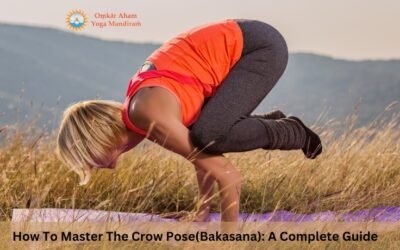Welcome to the ultimate guide on how to do Cobra Pose! Also known as Bhujangasana, Cobra Pose is a gentle backbend that helps to strengthen the spine and increase flexibility in the shoulders, chest, and abdomen. It is a great pose for beginners to start with, but it can also be modified for more advanced practitioners. By practising Cobra Pose regularly, you can improve your posture, reduce stress, and even relieve menstrual cramps. If you’re interested in deepening your yoga practice, consider enrolling in our Yoga Teacher Training Course, where you can learn more about yoga poses, philosophy, and teaching techniques. But for now, let’s dive into the steps for Cobra Pose!
Step By Step Guidance To Do Cobra Pose
It is critical to exercise the cobra pose in the proper position to minimize undue strain on the back, neck, and shoulders. Furthermore, specialists Suggest learners practice this posture under the supervision of a trained yoga teacher.
Well, here are step-by-step instructions to help you perform this stance carefully and with attention to correct body synchronization:
1. In a horizontal position, lie down.
Lie touch the ground on your mat, stretching your entire body. Gently push your legs and toes into the carpet on the floor and extend your legs to a hips-width length.
2. Place your hands on the area between your shoulder.
Proceed to elevate your middle and top body by putting your hands facing down just beneath your shoulder blades.
3. Start to Elevate your upper body.
Raise the arms and shoulders with your hands and slowly start in a low cobra. Make sure that you are not putting excessive load on your hands, as you need to strengthen the muscles in your lower back to move comfortably.
4. Rise upward by employing the muscles of the lower back.
When you find comfort in a low cobra pose, extend softly into the hands much more, elevating as far as you safely can into a broader backbend using your back and abdominal muscles. Start inhaling and exhaling freely through the nose.
As you pull your chest upward, hold your shoulders down to the floor. You do not need to maintain this stance; fully stable and can change shape and wriggle like a snake.
5. Mildly forward and upward.
Maintain a straight look but considerably upwards. Confirm that the surface of your torso is long enough to allow for good vertebral balance. You can hold this position for a few minutes, retaining spinal alignment and breath stability.
6. Gradually come down.
After taking a deep breath, slowly lower yourself to the ground.
7. Make the switch to another position.
There are a couple of commonly used postures to shift into after cobra: Balasana (child’s pose) and Adho Mukha Svanasana (reversed child’s pose) (downward-facing dog).
Some Tips To Exercise Cobra Pose Correctly
Here are some guidelines to guarantee that you correctly execute the cobra stance and reap all of its benefits. Carefully follow the below instructions to make sure the right instance.
- Proceed cautiously: To build strength and achieve satisfactory alignment, it’s essential to start gradually, even if only a few inches above the floor.
- Make use of your legs: Concentrate on ultimately lowering your feet into the mat, rising your kneecaps, and contracting your quads.
- Create more space: While bringing your legs down all the way, balance yourself and raise your torso forward to relieve any lower back tightness.
- Take Rest: While it’s normal to experience uncomfortable in cobra posture because most of your muscles are tensed, it’s crucial to keep your shoulders relaxed and your respiration regular. Maintain flexible shoulders that are pushed into your upper back, not stiff around your ears.
- Experiment with your hands’ strength: As you strengthen the muscles, add a little more weight to your hands. but experiment with raising them off the mat for a brief moment (if comfortable) and using only your back muscles to raise them.
How To Alter Cobra Stances
If the cobra position is too challenging or you’d like to begin more slowly, consider baby cobra. A simplified variation that demands minimal backbend.
For doing the baby cobra, repeat the same procedures as for the cobra position, except that you should prevent exerting any pressure on your hands. hold your eyes down and your spine long, and raise only halfway up.
This adjustment is appropriate for individuals who suffer from back problems or aspire to progress to an entire cobra stance. It seems to be an excellent alteration if you’re practising more therapeutic yoga.
Precautions During This Yoga
- People who are suffering from any problem related to their Back muscles or Spine, should avoid this yoga stance. It may cause harm to a further extent.
- If any person has abdominal pain or has a wrist or rib injury in their body, also try to not do this pose.
- Pregnant Women also avoid performing this posture or should do it under the guidance of a professional.
How To Exercise This Asana Safely To Prevent Any Lose
Proper technique is required to perform this pose with effectiveness. It is generally suggested that it is best to perform under the guidance of professional yoga trainers. Hence, make sure to do this pose safely.
In any health condition, first, consult with an expert and then start yoga exercises. You can also join our 200-hour yoga teacher training in Rishikesh to get the best out of it.
Conclusion
We hope this guide on how to do Cobra Pose has been helpful in improving your yoga practice. Remember to take it slow and listen to your body, and if you experience any pain or discomfort, stop immediately. With regular practice, you’ll find yourself becoming stronger, more flexible, and more mindful both on and off the mat.
You can join our 300 Hours Yoga Teacher Training, Rishikesh. For more details contact us at:
Call/WhatsApp: +91-9997744876
Mail us at: info@yogateachertrainingschool.com




